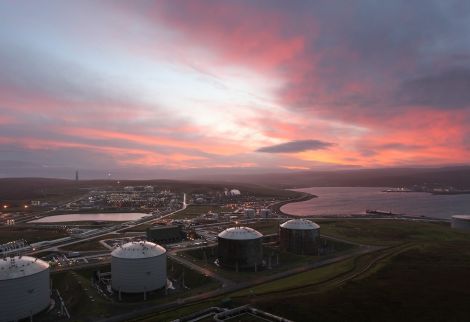News / Go-ahead for BP’s £500m gas sweetening plant
PLANS for a huge £500 million gas “sweetening” plant as part of energy giant BP’s renewal of the Sullom Voe Oil Terminal sailed through a meeting of Shetland Islands Council’s planning committee on Tuesday.
Construction could begin by the end of this year and it is expected the development will take the number of construction workers on the site to around 500 until the end of this decade.
The latest boost to employment in the north of Shetland was welcomed by councillors.
But there was frustration from committee members at the paltry fee of less than £20,000 paid to the local authority’s heavily burdened planning department to handle an application worth half a billion pounds.
Its resources have been overstretched dealing with some of Europe’s biggest energy developments in recent years, but rules laid down by Holyrood prevent it from charging fees more in proportion with the scale of those projects.
Planning board member Andrea Manson described the fee as “ridiculously low given the amount of staff time that’s used on it” and said it was “something we’ve got to fight with the government about”.
SIC head of planning Iain McDiarmid said the same had been true of the application for the similarly huge Total gas plant project.
His staff have also been working on major developments such as the new Anderson High School, while hundreds of hours were previously spent on dealing with a colossal environmental impact statement relating to Viking Energy’s windfarm plans.
Councillor Billy Fox raised his concern as the committee dealt with a retrospective application for permission to expand the Scatsta Quarry, which was approved.
McDiarmid said the department dealt with “in the region of 500 planning applications a year”, and the task of policing all of them was “very considerable indeed”.
Become a member of Shetland News
Fox sympathised and said the low fees and lack of resources were “something we need to be raising on a national level continually”, and that the blame should be “set fair and square at the door of the Scottish Government”.
Planning board chairman Frank Robertson praised the “excellent” quality of the officers’ report on the gas sweetening plant, adding: “It’s a massive application indeed, and once again Shetland as a small local authority is handling some of the biggest applications in Scotland.
“It’s a very complete report and there is a very strict and onerous set of conditions here that’s applicable prior to any works commencing.”
Misgivings over the planning fees aside, councillors were warmly receptive to the application. The project lies within Manson’s North Mainland constituency, and after the meeting she was enthusiastic that it will create “quite a lot of jobs”.
“I’m absolutely delighted that they’ve got planning permission for it today,” she told BBC Radio Shetland, “and it’s another step towards making sure Sullom Voe is there long after my retirement age.”
The gas sweetening plant itself will swallow up two hectares of the Sullom Voe site adjacent to the existing oil terminal. Including lay-down areas and other associated infrastructure the project will cover 16 hectares of land.
The plant will be used to process and remove hydrogen sulphide from “sour” gas transported from west of Shetland fields by incineration.
The sweetened gas will then be transported from an east of Shetland pipeline to the Magnus field for use during “enhanced oil recovery” or in the domestic gas market.
The planning committee unanimously backed the plans, which feature a 55-metre high incineration stack and a main flare stack which will stand at 70 metres.
Robertson said he welcomed conditions relating to the impact on Shetland’s road network – including assurances that pre-fabricated modules will be transported onto the site via the terminal’s construction jetty, minimising the heavy loads to be borne by the isles’ roads.
Officials’ thorough report stated that there were no outstanding objections to the development as it sits within an already heavily industrialised landscape, meaning it will have “minimal” visual impact.
“I think the extraordinary wear and tear that’s going to be occur on the public roads has been well addressed by the roads service,” Robertson said.
- Meanwhile permission has also been granted for the temporary accommodation block at Sella Ness, put in place to house construction workers for Total’s gas plant, to remain on site until November 2020.
It had originally been given consent until November 2015 or whenever the gas plant’s construction is completed, whichever was sooner.
The planning committee heard on Tuesday that even after the gas plant is finished there will continue to be demand for workers’ accommodation for several years.
Applicant Malthus UK Ltd said it envisaged the Sella Ness block being used to address a shortfall in temporary housing for the workforce expected to be employed on future developments in oil, gas, energy and other industrial sectors in the islands.
Robertson said the application made sense because accommodation was at an “absolute, utter premium” in Shetland.
Become a member of Shetland News
Shetland News is asking its many readers to consider paying for membership to get additional features and services: -
- Remove non-local ads;
- Bookmark posts to read later;
- Exclusive curated weekly newsletter;
- Hide membership messages;
- Comments open for discussion.
If you appreciate what we do and feel strongly about impartial local journalism, then please become a member of Shetland News by either making a single payment, or setting up a monthly, quarterly or yearly subscription.

























































